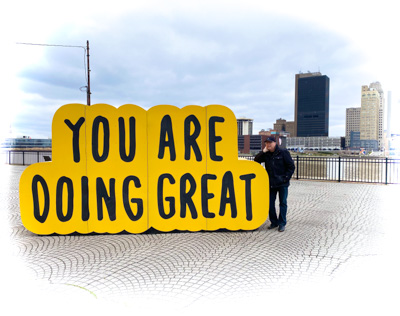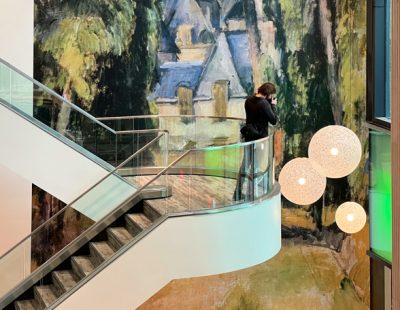Marcy Kaptur is right. This country is run by wealthy people on the East Coast and West Coast, and they don’t relate to the vast working-class people of the Midwest. Rep. Marcy Kaptur of Toledo, who holds the record for being the longest-serving woman in Congressional history, said the floor of Congress had always been lively with debates on the issues, but now it’s just a theater playing to the media.
You might think Ms. Kaptur was talking about the Toledo Museum of Art.
The 2022 Burns Halperin Report
The 2022 Burns Halperin Report is a survey which illustrates an extreme lack of diversity among 31 American museums, specifically, art made by Black Americans and women. The Toledo Museum participated in the survey. The survey mentioned only a couple of East Coast and West Coast museums doing a good job adding diversity to their new collections. Although the Toledo Museum of Art has a good record, it was not mentioned.
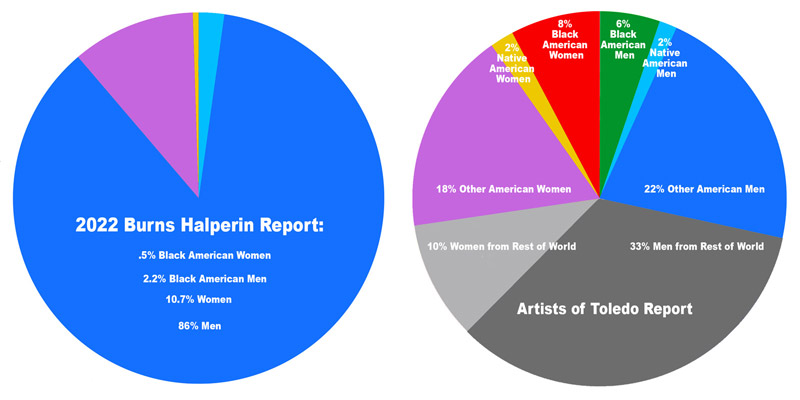
The Artists of Toledo Report
The Artists of Toledo Report is a survey of the artists whose art was acquired by the Toledo Museum of Art between 2017 and 2022. The survey shows that the Toledo Museum of Art has been almost completely balanced regarding the diversity of the artists whose work was collected during the past six years, except for a 30% imbalance between non-American women and non-American men.
Just passing through…
Mr. Levine has laid out a road map for the museum to become what he calls the “model museum in the United States,” one whose collection reflects the demographic makeup of the country, and where people feel “a sense of comfort and psychological safety in every interaction with the institution’s brand on-site and off-site,” as he put it. Itʼs About Time.ʼ Museums Make Bids for Their Communities. New York Times, May 21, 2021
The Toledo Museum has never had to try so hard to be a “model museum,” the museum has democratically served the entire community since 1901. However, certain new museum directors passing through on their upwardly mobile path in the museum world have stripped our museum of its democracy. The current director, Adam Levine, is from New York. He plays to the East Coast and West Coast media with disingenuous rhetoric, seeking publicity by exploiting the diversity issue.
Never mind that the museum’s revered public art education program and local artist shows that went on for nearly 100 years have been eliminated.
The Big Middle
The Toledo Museum of Art is in Marcy Kaptur’s district. Like Marcy Kaptur, the museum has a solid progressive democratic foundation that serves the working-class. The Toledo Museum of Art used to have a formidable public art education program. It had a local artist exhibition tradition unlike any other museum in the country. The educational program and the local art shows served multiple generations of Toledoans. These are the roots of the museum, through which the collecting of diverse art has evolved naturally.
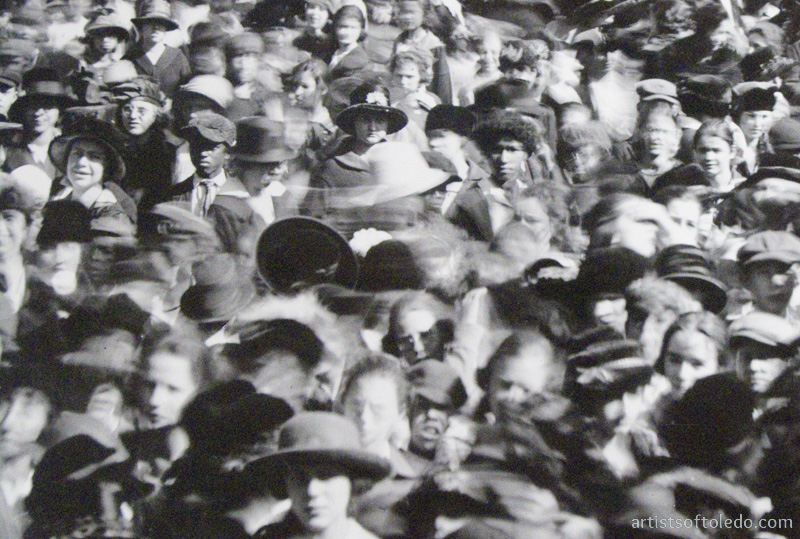
Frederick Douglass Allen, born in 1886, is the earliest recognized black artist in Toledo. He was one of the first students of the museum’s public art classes. He showed in the first annual Toledo Area Artists Exhibition, and seven subsequent annual shows at the Toledo Museum of Art. I spoke to the Warren AME Church, where Frederick Douglass Allen was a member, about any history they knew of blacks and the Toledo artist community. I learned that the early black community had more urgent priorities to deal with when they migrated to Toledo, so the artist Frederick Douglass Allen was ahead of his time.
As for women, Nina Spalding Stevens, wife of the 1903–1926 museum director, George W. Stevens, served as the associate director of the museum. She also created the educational program. If there has ever been a bias against blacks and women at the museum, it would be difficult to find. The art classes and shows provided a level playing field for a diverse community of artists. Many scholarship recipients were blacks and women. The local solo shows have always been diverse. In the 1970’s the museum hosted two group shows for the “Black Artists of Toledo.”
In the 1990’s, with the first black Trustee appointed to the Toledo Museum of Art Board of Directors, an initiative was begun to add more diversity to the collection. To understand the museum’s collection of “diverse art,” one must first understand that “diverse art” is made by contemporary artists, and the Toledo Museum of Art barely collected contemporary art until the 1960’s. Today the museum board itself is quite diverse, with a track record for adding diversity to the museum’s acquisitions.
Beauty without bias
“The superpower that an art museum has is when something goes up on the wall, it’s considered good. We set the cannon.” Adam Levine quoted in Forbes, ‘Beauty Without Bias’ At The Toledo Museum Of Art, Feb. 28, 2022
In his arrogance, Adam Levine claims that museums are in the unique position to put anything on their walls and call it art, and because it’s in a museum it is considered good. How odd for the Toledo Museum director to suggest that collecting art at our fine museum could be turned into a political anthropology experiment. The connoisseurship of our curators is what has grown our collection. Our museum is about great art — not politics. It’s about skilled curation, and then letting people decide for themselves what they like. That Adam Levine brought in a Branding Department to redefine our museum, after ripping out the democratic soul of the local community from the museum, using diversity to attract the attention of other museums (and grant foundations), is such a conceit. How ironic that, with such a record for collecting diverse art in the past six years, our museum didn’t get even as much as a peep in the 2022 Burns Halperin Report. But then we are in the Big Middle, and nothing can take the museum out of it, so Adam Levine might as well be content with making our museum functional again for our own large Midwest community, as unexciting for him as that might be.
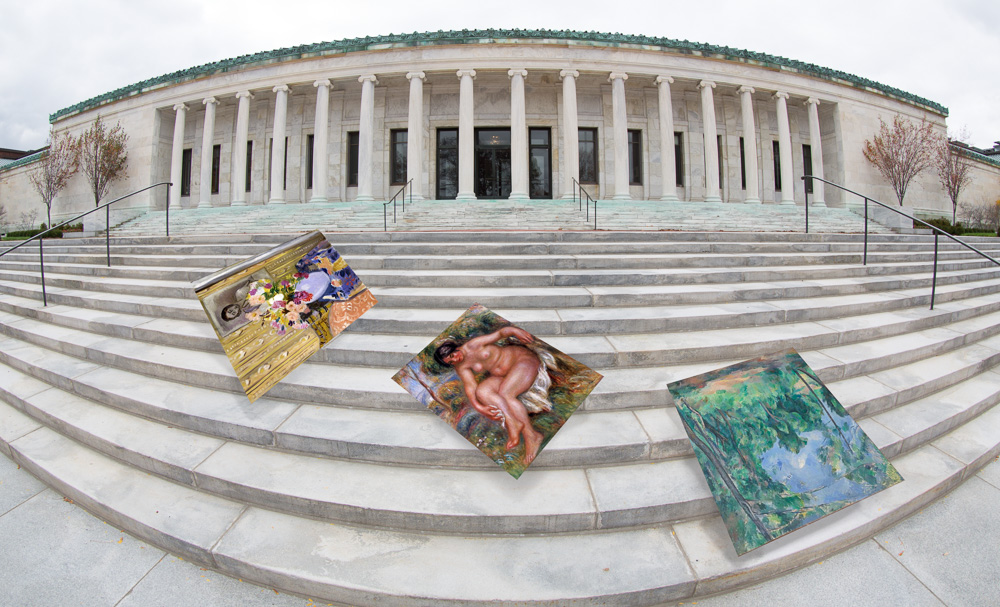
Cannibalizing our museum
The biggest hoax on the community was Adam Levine selling our historic French Impressionist paintings while quoting Edward Drummond Libbey, “let the multitudinous array of the mediocre be relegated to the past and in its place be found the highest quality, the best examples and the recognition of only those thoughts which will stand for all time,” as if Libbey would approve of the selling of our major Cezanne, Matisse and Renoir paintings. Adam Levine claimed that the sale was for “diversity,” when over the past six years, the museum has meticulously added an equitable ratio of Black Americans to Women to Other American artists acquired by the museum. He lied about data. He betrayed a peer museum in Chicago by reneging on a loan of our Cezanne painting for their show. He lied about the quality of the paintings being sold, and the intentions of the museum. Two paintings were sold to the same buyer for $59 million! Eight months later the Toledo Museum of Art does not have one artwork purchased with that money to show for it.
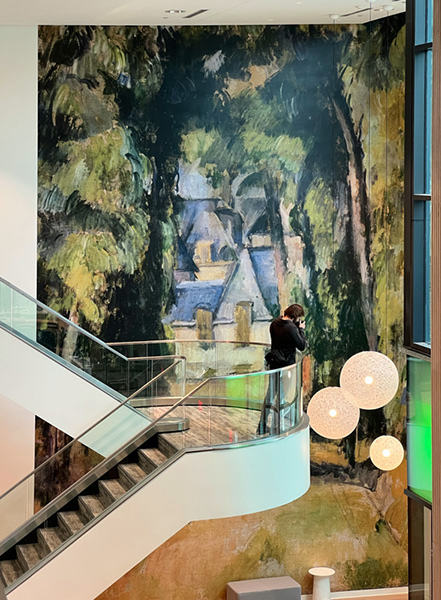
Impressionism speaking for our community
It is sad to see the museum’s French Impressionist paintings commercialized at the brand-new Lucas County Glass City Convention Center — including our only remaining Cezanne, Avenue at Chantilly, which is featured as anonymous wallpaper framing a multi-level staircase. This is the painting that was promised to the Chicago Cezanne Exhibition. Obviously, the museum and the Lucas County government believe that Impressionism speaks for our community. They are also using an uncredited Van Gogh for their two-story escalator alcove and a uncredited Monet on a large vinyl mural to decorate the second floor hallway. According to The Blade’s news story on the new Public Art, the convention center is “showcasing the museum’s collection.” Yet just eight months ago, the museum sold three original paintings from their small and valuable Impressionist collection that people came from near and far to see. That Adam Levine chose these paintings for the convention center, out of 30,000 possible choices, right after the unpopular and controversial deaccession of the Impressionist paintings, shows a frightening lack of honesty, integrity, vision, sensitivity and leadership.
Pass the remote, please
Recently, a new communications manager was hired at the museum who lives in Lansing Michigan. Her message to the people of Toledo was that Toledoans want to see themselves on the walls. The irony of an out-of-towner telling Toledoans what they want to see at the museum! The museum has a new department — Branding — and the director of the Branding department lives in Colorado. The Curator of Antiquities, Carlos Picon, is an art dealer in New York. (no kidding!) The African Art Curator, Lanisa Kitchiner, is the Chief of African and Middle Eastern Division at the Library of Congress in Washington D.C. Why is our museum director turning the controls over to the East Coast and the West?
We can be thankful to Marcy Kaptur for working so devotedly for our Midwest community for the past 41 years. We are extremely lucky to have her fighting for us in Congress for all these decades. The Toledo Museum of Art has had seven directors during those 41 years. (If only we could have cloned Otto Wittmann, the museum’s fourth director, who grew the museum for 30 years.)
Marcy Kaptur is the real deal. With Marcy Kaptur, as with the Toledo Museum of Art, you won’t know what you are missing until it is gone.
Another “real deal” is Samuel “Golden Rule” Jones, mayor of Toledo 1897-1904, whose house stood where the Toledo Museum of Art Peristyle stands today, and who inspired Marcy Kaptur so much that she wrote her college thesis on him. See my post from 2021 to put into perspective the progressive beginnings and democratic legacy of the Toledo Museum of Art: Whitlock, Jones and June Boyd
